The International Rice Genebank, maintained by IRRI, holds more than 132,000 available accessions as of December 2019. This includes cultivated species of rice, wild relatives and species from related genera.
The genebank is the biggest collection of rice genetic diversity in the world. Countries from all over the world send their rice to IRRI for safe keeping, and for sharing for the common public good.
Traditional varieties and the wild species of rice are being lost through genetic erosion. Farmers adopt new varieties, and cease growing the varieties that they have nurtured for generations and eventually lose these varieties.
Wild species are threatened with extinction as their habitats are destroyed by human disturbance. Future crop improvement needs the genetic variation from traditional varieties and related wild species to cope with the many biotic and abiotic stresses that challenge rice production around the world.
IRRI works to ensure the long-term preservation of rice biodiversity as part of the global strategy for the conservation of rice genetic resources. This is in partnership with national programs and regional and international organizations worldwide, including the CGIAR Research Program for Managing and Sustaining Crop Collections.

Different species of rice
The species of rice conserved in the International Rice Genebank include:
- Oryza sativa or Asian rice, which is the most commonly grown and eaten rice. It probably had its origin between the Himalayas and Indochina and contains two groups of rice: indica and japonica (including temperate and tropical japonica)
- Oryza glaberrima or African rice originated in West Africa. It is not widely cultivated but has been used to breed other types of rice grown in Africa.
- Twenty-four wild species of rice that are found in Asia, Africa, Australia, and the Americas.
- Nine species from seven related genera
Storing and sharing rice seed
Each type of rice in the International Rice Genebank is stored in both the base (-20 degrees Celsius, long-term storage) and active ( 2-4 degrees Celsius, for distribution) collections.
The viability of rice seed can decline very quickly (over months) when stored in conditions more typical of how a rice farmer in Asia may store seed, depending on climate and initial seed quality. For example, if the initial viability of a rice seed sample is 95% (that is, 95% of the seed will germinate) and it is kept at a temperature of 30 degrees Celsius, with 70% relative humidity, and with a seed moisture content of 13.5% (fresh weight basis), seed viability would be 1% after just 5 months.
In the International Rice Genebank, rice seeds have the potential to remain viable for many decades. Viability testing of all samples is carried out every 5 years for seed stored in the active collection, or every 10 years for seed stored in the base collection. If viability falls below 85%, a sample of the remaining seeds is planted to produce fresh seeds for storage.
IRRI continually assesses management procedures in the International Rice Genebank to ensure that the best practices are employed to conserve this vital genetic resource for future generations.
Following extensive negotiation among all the contributing countries, IRRI now manages the rice collection stored in the International Rice Genebank under the International Treaty on Plant Genetic Resources for Food and Agriculture. We supply free samples of different types of rice seed to any prospective user on request, according to the conditions of the Treaty.

Genetic information
With access to the world’s largest collection of rice, we have a unique opportunity to study the diversity of rice. IRRI characterizes rice for its traits and genetic makeup to find useful versions of genes.
We work with the International Network for Genetic Evaluation of Rice (INGER), a global model for the exchange, evaluation, release, and use of genetic resources. The data of all the rice conserved at IRRI are efficiently managed and maintained by an in-house developed information system and made accessible through the public website IRRI Germplasm Resource Information Network-GLOBAL (IRRI GRIN-Global).

